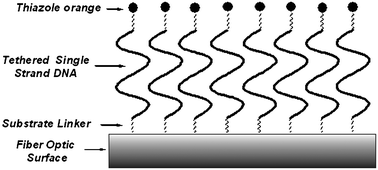A self-contained fluorescent fiber optic DNA biosensor
Abstract
Single-stranded DNA (ssDNA) sequences can be used as probes to detect complementary targets, and represent useful analytical reagents for the detection and identification of bacteria, viruses and mutations. The hybridization process between probe sequences immobilized at a surface and complementary nucleic acid targets in a sample solution can, under optimal conditions, be complete in several minutes with a high degree of selectivity. Fluorescent dyes such as thiazole orange (TO) have been used extensively to quantify DNA by measuring the differential spectroscopic properties of free dye and the dye that associates with double-stranded DNA by intercalation. In an effort to develop a reagentless biosensor, TO has been covalently tethered by various poly(ether) strands at the 5′ end of ssDNA probes, in a detection system where the oligonucleotide probes are immobilized onto the surfaces of fused silica optical fibers. Characterization of the surface immobilization has been completed using X-ray photoelectron spectroscopy. The biosensors provided changes in steady-state fluorescence intensity signals upon hybridization, that reached saturation in seconds to minutes, and were able to provide a quantitative determination of hybridization at nanomolar detection limits. Aspects such as ionic strength, length of the tether that was used to attach TO to ssDNA, and the packing density of the probe molecules were examined to determine the influence of these parameters on the thermodynamic and kinetic performance of the biosensor. In a preliminary investigation of this application, the biosensor was used to detect PCR products from Erwinia herbicola.

- This article is part of the themed collection: Fluorescent sensors

 Please wait while we load your content...
Please wait while we load your content...